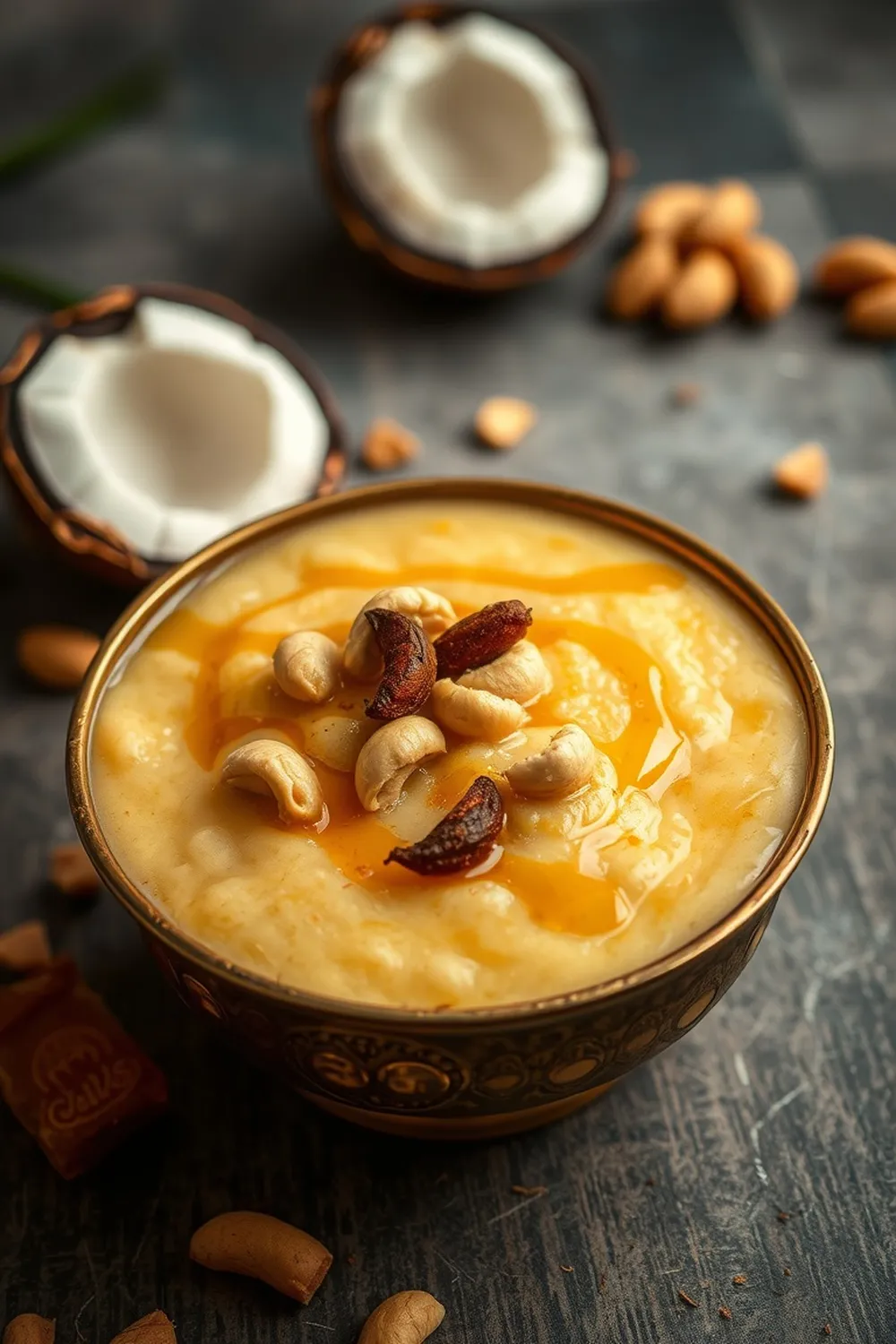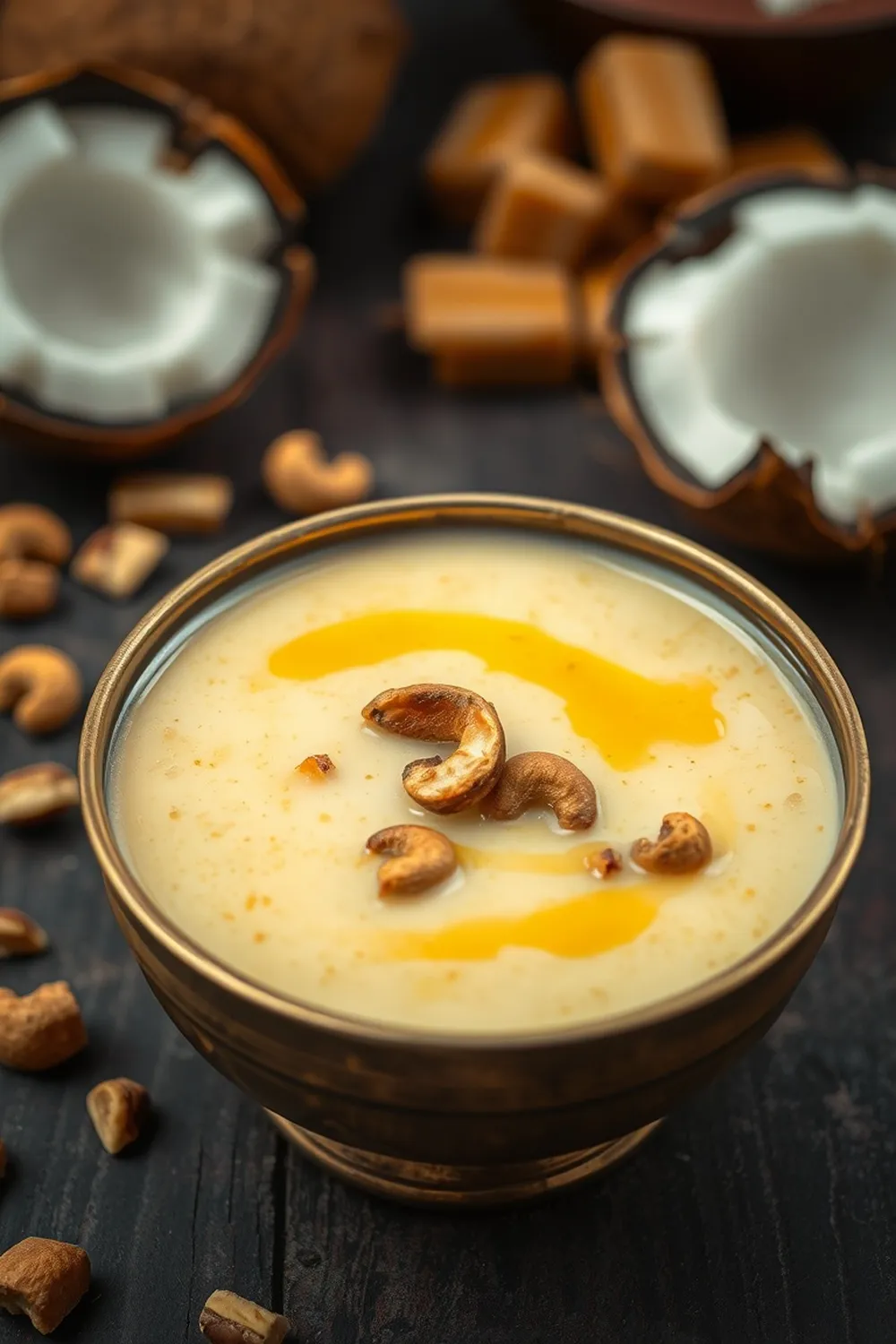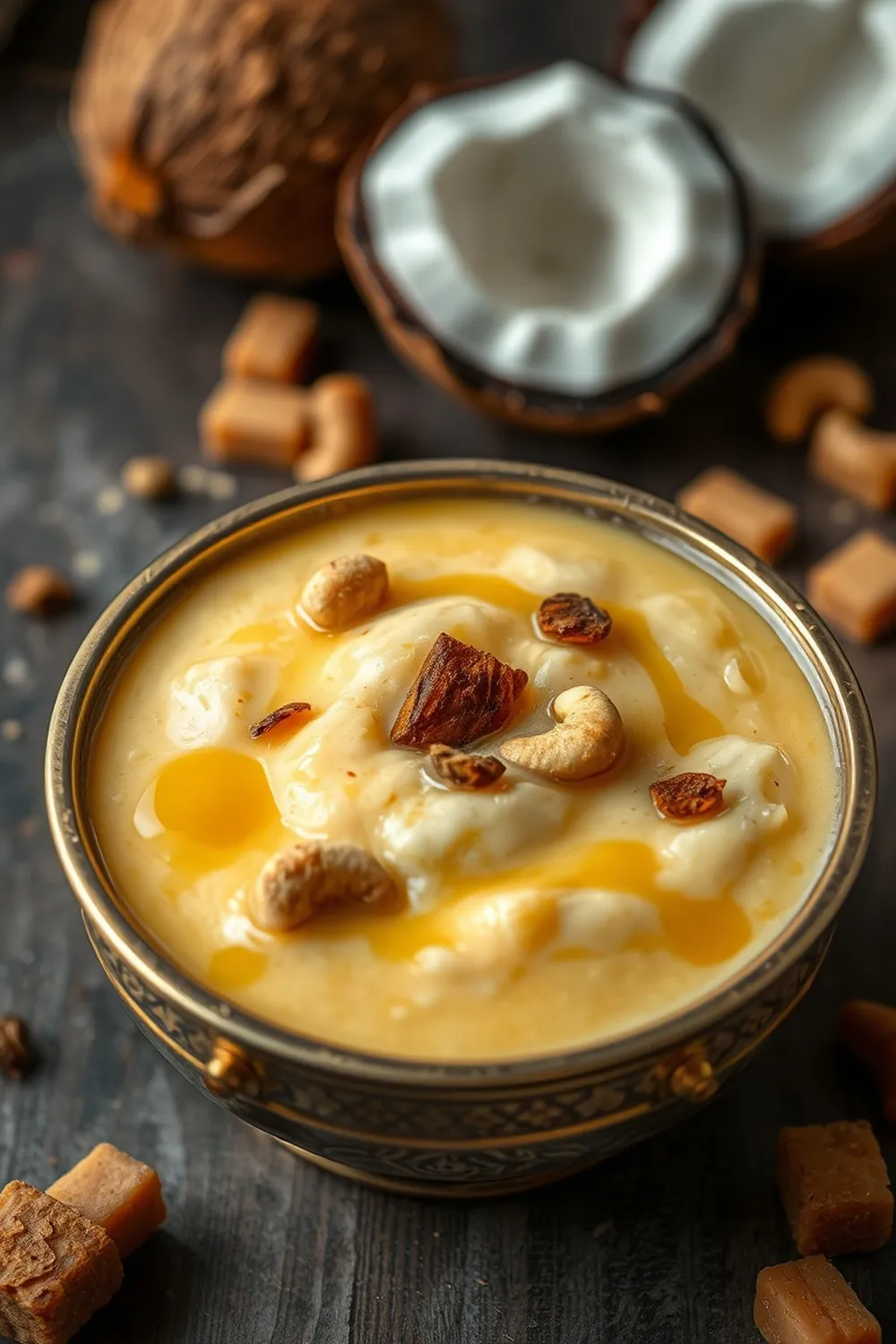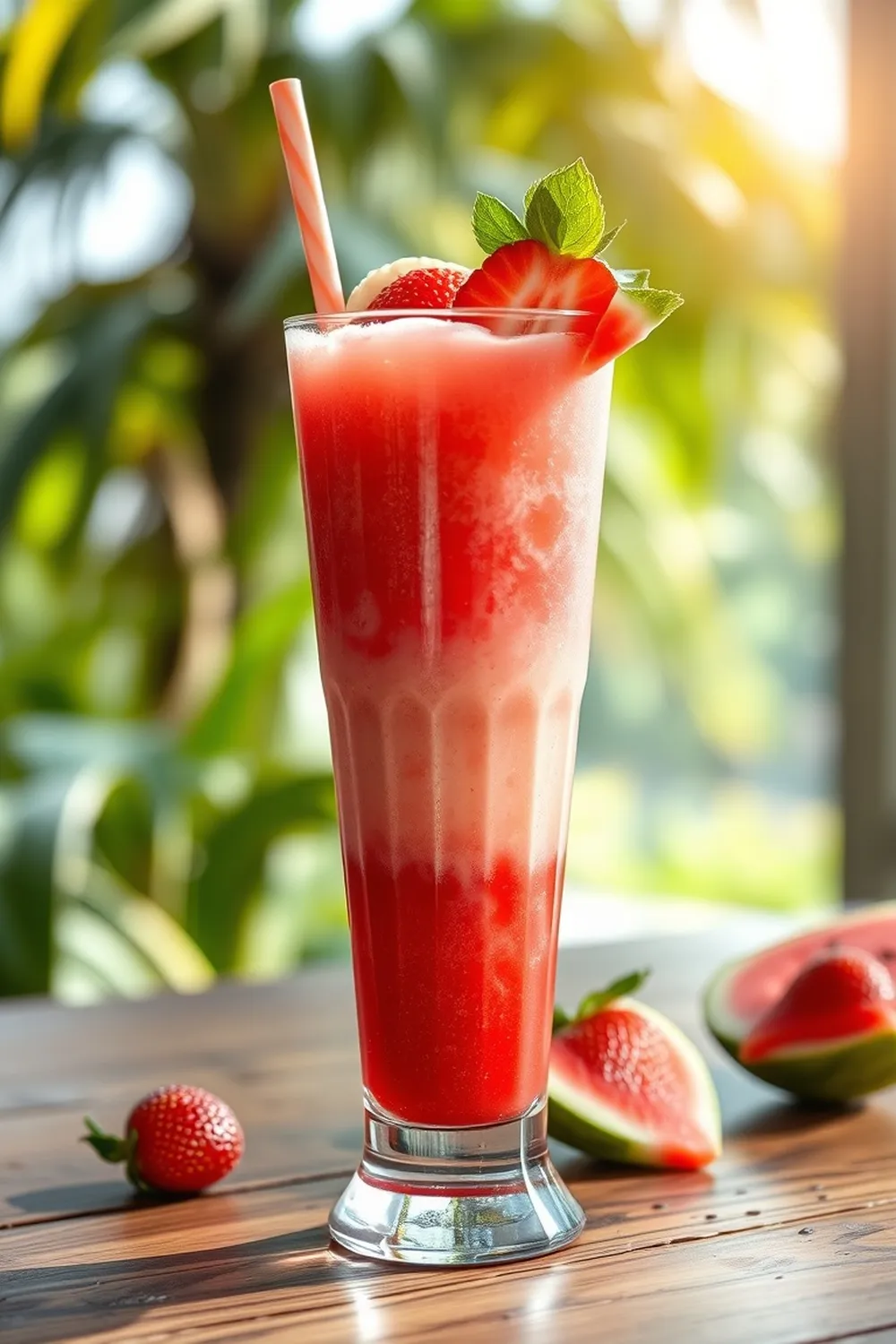- Grate coconut and grind with raw rice and 1 cup of warm water. Strain to extract the first milk. Repeat with 1/2 cup water for the second milk. Combine both milks.
- Melt jaggery with 1/4 cup water. Strain the syrup and simmer until the raw smell disappears.
- Mix the coconut milk into the jaggery syrup. Simmer for 3-4 minutes without boiling vigorously.
- Add cardamom powder. Fry cashews in ghee and mix into the payasam. Serve warm.
- Calories:350 kcal25%
- Energy:1464 kJ22%
- Protein:5 g28%
- Carbohydrates:50 mg40%
- Sugar:30 mg8%
- Salt:20 g25%
- Fat:15 g20%
Last Updated on 6 months ago by Neha Deshmukh
Authentic Coconut Payasam Recipe – Kerala Style Jaggery Dessert
Hey everyone! If you’re anything like me, you have a serious sweet tooth, and you love a good traditional Indian dessert. Today, I’m sharing one of my absolute favorites – a creamy, dreamy Coconut Payasam, made the authentic Kerala way with jaggery. This isn’t just a recipe; it’s a little piece of my childhood, and I can’t wait to share it with you.
Why You’ll Love This Recipe
This Kerala Coconut Payasam is special. It’s comforting, subtly sweet (thanks to the jaggery!), and has a beautiful, delicate texture. It’s also surprisingly easy to make, even if you’ve never attempted Indian desserts before. Plus, it’s perfect for festivals, celebrations, or just a cozy night in. Honestly, a warm bowl of this feels like a hug!
Ingredients
Here’s what you’ll need to create this magic:
- 1 cup grated coconut
- 1 tbsp raw rice
- ½ cup grated jaggery
- 2 cardamom pods
- 5 cashews
- 2 tsp ghee
- 1 cup + ¼ cup warm water (approximately 240ml + 60ml)
Ingredient Notes
Let’s talk ingredients! Getting these right makes all the difference.
- Coconut: In Kerala, we use freshly grated coconut whenever possible. It has a unique sweetness and aroma. If you can’t find fresh, unsweetened desiccated coconut works well too.
- Jaggery: Jaggery is unrefined cane sugar, and it gives this payasam a beautiful color and a complex, molasses-like flavor. You can find it in Indian grocery stores. Darker jaggery has a stronger flavor.
- Rice: We use raw rice (unpolished rice) here. It helps thicken the payasam beautifully. Don’t worry, it cooks down completely!
- Ghee: Ghee, or clarified butter, adds a lovely richness. Using a good quality ghee really elevates the flavor. I prefer homemade, but store-bought works just fine.
Step-By-Step Instructions
Alright, let’s get cooking! Don’t be intimidated, it’s simpler than it looks.
- First, let’s make the coconut milk. Grate the coconut and grind it with the raw rice and 1 cup of warm water.
- Strain this mixture really well, squeezing out all the milk. This is your first extraction.
- Now, repeat the process with the same grated coconut, but this time use about ¼ cup of warm water. This second extraction gives you a richer, creamier milk. Combine both milks in a bowl.
- Next, melt the grated jaggery with ¼ cup of water in a separate pan.
- Strain the jaggery syrup to remove any impurities. Then, simmer it over medium heat until the raw smell disappears – this usually takes a few minutes. You want a nice, syrupy consistency.
- Gently pour the coconut milk into the jaggery syrup.
- Simmer the mixture for 3-4 minutes, stirring constantly. Be careful not to let it boil vigorously, or the milk might split.
- Lightly crush the cardamom pods to release their aroma and add the powder to the payasam.
- Finally, fry the cashews in ghee until golden brown. Add them to the payasam and give it a good stir.
- Serve warm and enjoy!
Expert Tips
A few little things I’ve learned over the years…
- Straining is Key: Don’t skip straining the coconut milk and jaggery syrup! It ensures a smooth, silky texture.
- Gentle Simmer: Low and slow is the way to go. Simmering gently prevents the payasam from sticking or splitting.
- Taste Test: Adjust the sweetness to your liking. Jaggery sweetness varies, so feel free to add a little more if needed.
Variations
Want to switch things up? Here are a few ideas:
- Vegan Adaptation: Use full-fat coconut milk instead of making it from scratch, and substitute the ghee with vegan ghee. It’s just as delicious!
- Gluten-Free: This recipe is naturally gluten-free!
- Spice Level: If you love a stronger cardamom flavor, add another pod or a pinch of cardamom powder.
- Festival Adaptations: During Onam or Vishnu, my family loves to add a few strands of saffron for a touch of luxury.
Serving Suggestions
This payasam is wonderful on its own, but it also pairs beautifully with other Indian dishes. I love serving it after a spicy meal to cool things down. A sprinkle of chopped nuts on top adds a nice crunch.
Storage Instructions
Leftover payasam can be stored in an airtight container in the refrigerator for up to 3 days. It will thicken as it cools, so you might need to add a splash of milk or water when reheating.
FAQs
Let’s answer some common questions:
- What type of coconut is best for Payasam? Freshly grated coconut is ideal, but unsweetened desiccated coconut works well too.
- Can I use coconut milk instead of making it from scratch? Yes, you can! Use about 2 cups of full-fat coconut milk.
- How do I know when the jaggery syrup has reached the right consistency? It should be syrupy and free of any grainy texture. A good test is to drop a tiny bit into cold water – it should form a soft ball.
- What is the significance of cardamom in this Payasam? Cardamom adds a beautiful aroma and flavor that complements the coconut and jaggery perfectly. It’s also believed to have digestive properties.
- Can this Payasam be made ahead of time? Yes, you can make it a day ahead. The flavors actually meld together even more beautifully overnight!
Enjoy making this delicious Kerala Coconut Payasam! I hope it brings a little bit of sunshine to your kitchen. Let me know how it turns out in the comments below!










